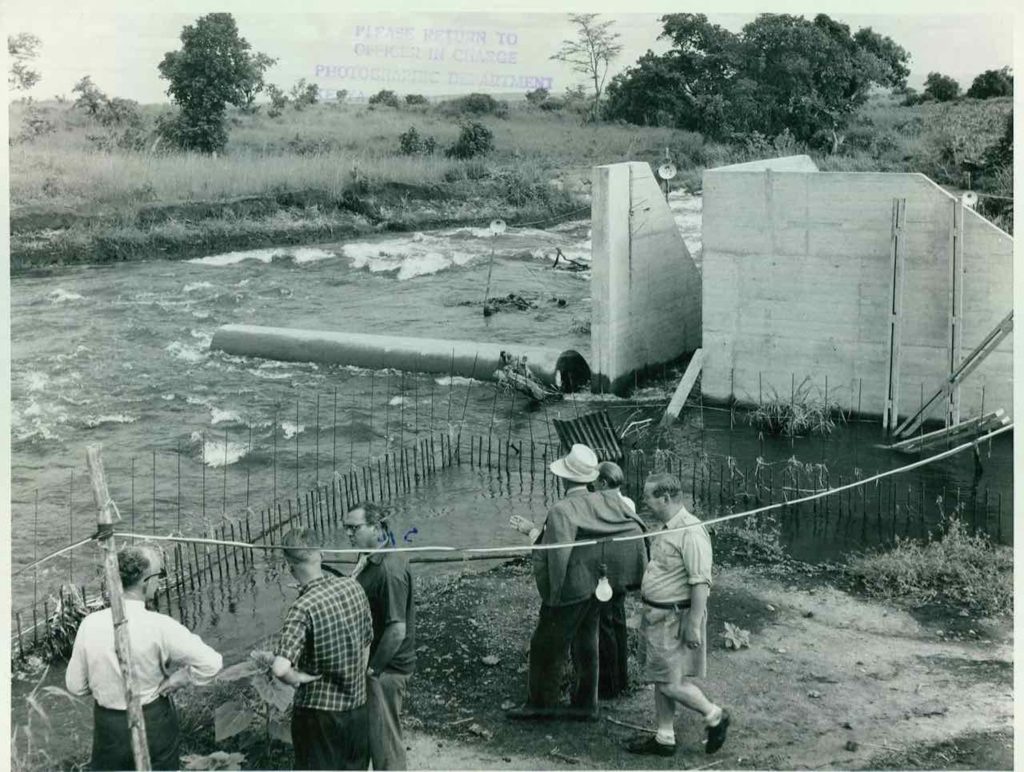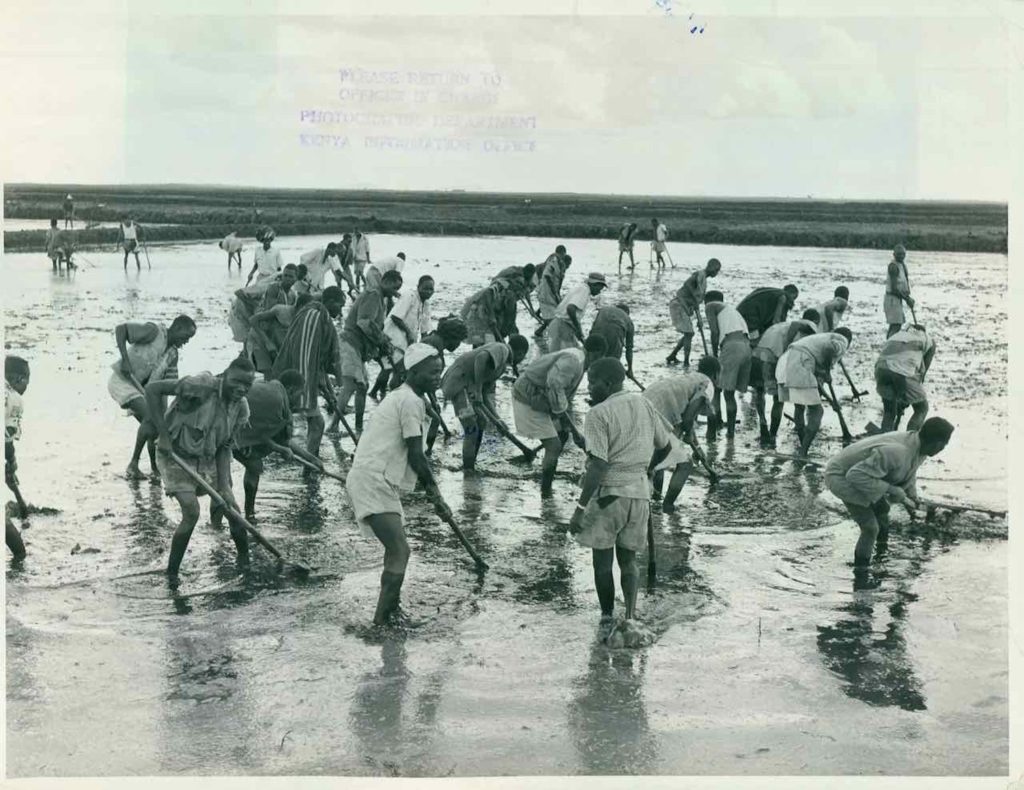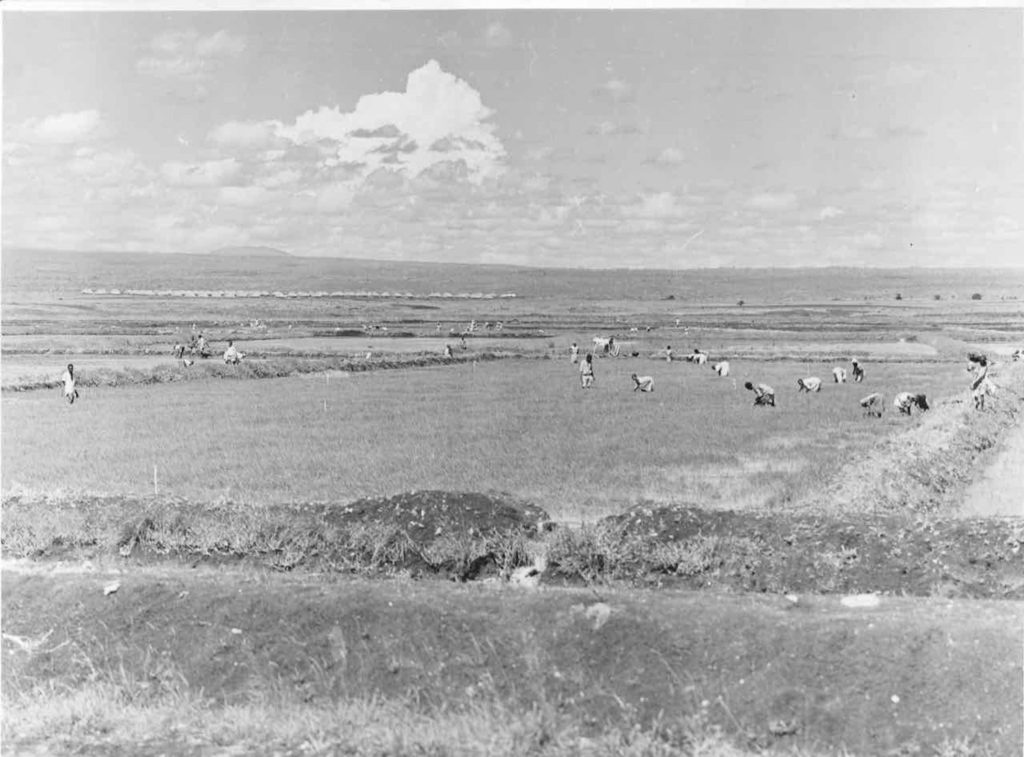The Connection Between the Mwea Irrigation Scheme and Kenya’s Independence Struggle
From Presidential Library and Museum Facebook/facebook.com/OPLMKe/
Before maize became the most favorite food on many African dinner tables, rice was grown in abundance in many parts of the continent. Rice is indigenous to Africa and Asia even though it has maintained its place as the number one staple food in the Asian world unlike on the African continent.
In Kenya, the history of rice cultivation in the pre-colonial era is not well documented but the cereal crop is an important part of the Kenyan diet. 80 percent of the rice produced in Kenya comes from the Mwea Irrigation Scheme which holds the record of being Kenya’s most successful irrigation project. Many Kenyans are familiar with the popular aromatic Mwea Pishori but few are familiar with the history behind the country’s booming rice irrigation project.
Except for mentions in school classrooms, majority of the younger generation of Kenyans do not know that the Mwea Tebere Irrigation Scheme, as it was originally known, was established using the labor of the men who fought for the country’s freedom from colonial rule. The hosting of this year’s Mashujaa Day celebration at Wang’uru Stadium which is right in the middle of the Mwea rice fields brings into focus the connection between the origins of the irrigation scheme and Kenya’s independence struggle. In the 1940s and 1950s, when many Kenyans took up arms to fight against the British colonial government, those who were unfortunate to be captured were sent to detention camps where they were tortured and forced to work.
In Mwea area, there were six detention camps holding thousands of Mau Mau fighters who were captured and detained by the colonial government The Mau Mau detainees were forced to level land in Tebere, the original section of the Mwea Irrigation Scheme. They were forced to dig canals to divert water from the River Nyamindi and River Thiba to irrigate the rice fields. The work on the first pilot project of the scheme was started in 1947. Work on the project continued into the early 1950s when many Kenyans joined the armed independence struggle against the British colonial government.
To suppress the increasing demand for independence, the British launched operations to kill or capture those who opposed their power in Kenya. Those who were captured alive were sent to the detention centers and many of them ended up in Mwea.
In 1963, Mwea Irrigation Scheme was taken over by the Government of Kenya and it has been treated as a flagship project by each successive Administration. The National Irrigation Authority, previously called the National Irrigation Board, wholly managed the scheme until the 1990s when it handed some roles to the farmers. During the colonial period there was no rice mill and the harvests were processed manually.
In 1973, Mzee Jomo Kenyatta opened a rice mill to enhance efficiency and production. Mzee Kenyatta also oversaw the construction of the Mwea Irrigation Road to improve accessibility and movement within the project. The scheme continued to thrive and the acreage under rice cultivation expanded and by the time President Daniel Arab Moi took over office in 1978, the scheme’s water supply was overstretched.
President Moi oversaw the overhaul of the infrastructure of water system infrastructure including the construction of new waterworks and canals. President Moi initiated the plan to construct a dam on Thiba Dam but the project could not be implemented following disputes between the rice farmers and the government. President Moi’s Administration also overhauled the rice mill.
Under the Administration of President Uhuru Kenyatta, Mwea Irrigation Scheme has been at the forefront of the Government’s food security agenda. In 2014, the rice mill that was installed in 1996 was replaced with a modern and efficient model.
The construction of Thiba Dam which will be completed by the end of the year is expected to transform Mwea Irrigation Scheme. The dam is designed to stabilize the water supply system for the existing farms and will also enable the scheme to be expanded by another 10,000 acres. The Manager of the Mwea Irrigation Scheme Board, Engineer Innocent Ariemba, says the completion of Thiba Dam will revolutionize the rice irrigation project. He says with uninterrupted water supply from Thiba Dam, farmers will be able to have more harvest seasons.
The dam will also provide a stable water supply to the Mwea settlement which has in recent years grown to be a thriving business center. Owing to the liberalization of the marketing of harvests, several private rice have sprung up in Mwea town, creating more employment as the town continues to grow steadily.
Engineer Ariemba said the National Irrigation Authority has continued managing the water systems of the scheme. The NIA has also been continuously undertaking research on better quality rice and has also led the way in guiding the farmers in embracing technology such as mechanized harvesting which improves the yields. Going back to the story of the original beginning of Kenya’s largest and most successful rice irrigation project, every time you take a scoop of the aromatic Mwea Pishori, always give a thought to the heroes who toiled and sweated to create the scheme.
Some of the heroes who were forced to set up the scheme with their bare hands in the 1950s are still alive and are among the Mwea farmers. Mzee Joseph Kibunja, 91 years, was captured by the British colonial government after he was shot and injured during an encounter between the colonial government forces and Mau Mau fighters inside Lare Forest. Mzee Kibunja had joined the Mau Mau after the British closed down a restaurant that he owned in Arusha, Tanzania he deported him back to Kenya penniless. After working for several years, he became one of the the first people to be allocated land in the scheme and is today among the model farmers in the area.
He recalls the hardship they were forced to go through by the colonial government. ” It makes me want to cry when I remember the mistreatment we went through as we were forced to work to build canals and level this land,” says Mzee Kibunja. He says many detainees died because of diseases like malaria and snake bites. “This place was full of wild animals and sometimes we will stumble on lions and hyenas,” says Mzee Kibunja.
Outside his home in Tebere, there is a huge mountain of stones and anyone asking for directions to his home would be told by the locals to “look for the home with rocks.” Kibunja explains the mystery of the gigantic pile of rocks, saying that every time a rock is dug up in his farm, he would carry it home. “I am sure this stones will have a good use one day. When my children decide to build houses they can use them,” he says.
Engineer Ariemba forwarded Mzee Kibunja’s name to be included in this year’s list of Kenyans who will be celebrated as Mashujaa.

A view of the main irrigation canal which leads water from Nyamindi River to the Mwea plain in 1956. 
Nyamindi water intake under construction on 5th June 1956. 
Mau Mau detainees leveling off a rice field in the Mwea swamp in 1956. 
Workmen digging small furrow to carry water to test plots in the scheme in 1949. 
Mwea irrigation scheme in 1956.

